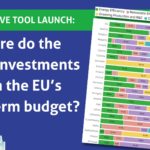To: European Commission – Executive Vice-President Frans Timmermans
Subject: Sustainable carbon cycles
Dear Executive Vice-President Timmermans,
We are writing to you in the context of the anticipated Sustainable Carbon Cycles Communication. We believe it has significant merits, but risks seriously undermining its own declared purpose of climate ambition.
First, the initiative has the potential to deliver important steps forward. We welcome that deep emission reductions take priority over carbon removals. While carbon removals are needed in the longer term to reach climate neutrality and net-negative emissions afterwards, what we need this decade are drastic emission reductions in order to keep global warming within the Paris Agreement’s 1.5°C limit.
Second, we support the domestic scope of the Communication and the announced Carbon Removal Certification Mechanism and the cautious approach on carbon removals before 2030. We recognise that space and time have now been allocated for gaining experience and knowledge in this area.
Finally, we welcome the increased transparency and improvement in climate accounting that will result from ensuring that each ton of CO2 captured, transported, used and stored will be reported and accounted for by its fossil, biogenic or atmospheric origin by 2028. This will be critical to get the framework for carbon removals right. It will ensure that captured industrial emissions are correctly labelled as fossil or biological, depending on their ultimate origin, and not based on a snapshot of a segment of a value chain.
Problematic aspects
However, we are gravely concerned that these positive elements will be negated by deeply problematic interactions with other policies which have their own specific aims. For instance, allowing for the trading of emissions offsets in EU regulatory and compliance frameworks in the EU’s Emissions Trading System (ETS), Effort Sharing Regulation (ESR) and the Land Use, Land use Change, and Forestry (LULUCF) Regulation after 2030 will be extremely detrimental and counter-productive. The trading of emissions offsets not only contradicts the stated priority of emission reductions over carbon removals, but it also fundamentally undermines the functioning of the above policy frameworks as drivers for effective emissions reductions. It is a zero-sum game that does not reduce emissions, and we do not have the luxury of time to waste on it given that emissions need to be reduced across all sectors and activities as fast and as deeply as possible.
In addition, carbon removals cannot be equated to GHG emissions reduction, and must be regulated separately. Emissions and removals should not be treated at policy level as tonne-for tonne equivalent and simply interchangeable. Instead, demand for removal units should be created through a separate target for removing carbon from the atmosphere. Demand for removals should not come from actors that still have scope to reduce their emissions and polluting companies should not be allowed to use removal offsets (including uncertain and reversible offsets in the land use sector such as carbon in soils or forests) as a means of avoiding carbon pricing or emissions cuts in their own value chains.
The Communication should, therefore, make no openings towards including removal offsets in the EU ETS or ESR, or for using forest sinks to offset agricultural emissions under the Agriculture, Forestry and Other Land Use (AFOLU) pillar (proposed in the revised LULUCF Regulation).
An even more worrying aspect is that some of the envisaged removals might not actually be real removals. Real removals take GHGs from the atmosphere and store them for (at the very least) centuries. The Commission must clearly define permanence of storage from the start to avoid confusion later in the process. Differentiation between permanent and short term storage is critical, and short or medium-term ‘stores’ of carbon (such as bio-plastics, building materials or other harvested wood products) should not be equated with permanent storage in any way.
In addition, we encourage the Commission to clarify the issue of liability if or when removals are reversed, and the stored carbon enters the atmosphere again. As explained above, nature-based removals (such as those envisaged through carbon farming) are at especially high risk of reversals. This needs to be acknowledged and addressed.
To conclude, the initiatives covered by the Communication have the potential to be beneficial, but the positive elements risk being undermined if openings are left for offsetting emission reductions with removals – some of which are not real removals. The EU has the opportunity to become a global leader in setting a high bar for climate ambition and ecosystem integrity, we hope this opportunity will not be squandered. We therefore urge you to reconsider these problematic elements, and would like to request a meeting with you before the expected adoption of the Communication to discuss this further. Thank you for your consideration.
Cordially,
Signed,
Sabine Frank, Executive Director (Carbon Market Watch)
Jonas Helseth, Director (Bellona Europa)
Barbara Mariani, Policy Manager for Climate (European Environmental Bureau) Shefali Sharma, Director (Institute for Agriculture and Trade Policy)
Chiara Martinelli, Director (Climate Action Network Europe)
Hannah Mowat, Campaigns Coordinator (FERN)
Lucie Mattera, Head of EU Politics (Third Generation Environmentalism – E3G)
Magda Stoczkiewicz, Programme Director (Greenpeace European Unit)
Ester Asin, Director (WWF European Policy Office)



